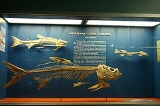
Clupeiformes
Encyclopedia
Clupeiformes is the order of ray-finned fish
that includes the herring
family, Clupeidae
, and the anchovy
family, Engraulidae. The group includes many of the most important food fish.
Clupeiformes are physostomes, which means that the gas bladder
has a pneumatic duct connecting it to the gut
. They typically lack a lateral line, but still have the eyes, fins and scales that are common to the fish
family, although not all fish have these attributes. They are generally silvery fish with streamlined, spindle-shaped, bodies, and they are often schooling. Most species eat plankton
, which they filter from the water with their gill raker
s.
Order Clupeiformes
Actinopterygii
The Actinopterygii or ray-finned fishes constitute a class or sub-class of the bony fishes.The ray-finned fishes are so called because they possess lepidotrichia or "fin rays", their fins being webs of skin supported by bony or horny spines , as opposed to the fleshy, lobed fins that characterize...
that includes the herring
Herring
Herring is an oily fish of the genus Clupea, found in the shallow, temperate waters of the North Pacific and the North Atlantic oceans, including the Baltic Sea. Three species of Clupea are recognized. The main taxa, the Atlantic herring and the Pacific herring may each be divided into subspecies...
family, Clupeidae
Clupeidae
Clupeidae is the family of the herrings, shads, sardines, hilsa and menhadens. It includes many of the most important food fishes in the world.-Description and biology:...
, and the anchovy
Anchovy
Anchovies are a family of small, common salt-water forage fish. There are 144 species in 17 genera, found in the Atlantic, Indian, and Pacific Oceans. Anchovies are usually classified as an oily fish.-Description:...
family, Engraulidae. The group includes many of the most important food fish.
Clupeiformes are physostomes, which means that the gas bladder
Gas bladder
The swim bladder, gas bladder, fish maw or air bladder is an internal gas-filled organ that contributes to the ability of a fish to control its buoyancy, and thus to stay at the current water depth without having to waste energy in swimming...
has a pneumatic duct connecting it to the gut
Gut (zoology)
In zoology, the gut, also known as the alimentary canal or alimentary tract, is a tube by which bilaterian animals transfer food to the digestion organs. In large bilaterians the gut generally also has an exit, the anus, by which the animal disposes of solid wastes...
. They typically lack a lateral line, but still have the eyes, fins and scales that are common to the fish
Fish
Fish are a paraphyletic group of organisms that consist of all gill-bearing aquatic vertebrate animals that lack limbs with digits. Included in this definition are the living hagfish, lampreys, and cartilaginous and bony fish, as well as various extinct related groups...
family, although not all fish have these attributes. They are generally silvery fish with streamlined, spindle-shaped, bodies, and they are often schooling. Most species eat plankton
Plankton
Plankton are any drifting organisms that inhabit the pelagic zone of oceans, seas, or bodies of fresh water. That is, plankton are defined by their ecological niche rather than phylogenetic or taxonomic classification...
, which they filter from the water with their gill raker
Gill raker
Gill rakers in fish are bony or cartilaginous processes that project from the branchial arch and are involved with filter feeding tiny prey. They are not to be confused with the gill filaments that compose the bony part of the gill. Rakers are usually present in two rows, projecting from both the...
s.
Families
The order includes about 300 species in six families:Order Clupeiformes
- Family Denticipitidae (denticle herring)
- Family Engraulidae (anchovies)
- Family PristigasteridaePristigasteridaePristigasteridae is a family of fish related to the herrings, and including the genera Ilisha and Pellona. The taxonomic classification of this family is in doubt. One common name for the taxon is longfin herring....
- Family Chirocentridae (wolf herrings)
- Family ClupeidaeClupeidaeClupeidae is the family of the herrings, shads, sardines, hilsa and menhadens. It includes many of the most important food fishes in the world.-Description and biology:...
(herrings, sardines, shads, and menhadens) - Family Sundasalangidae (Sundaland noodlefishes)

